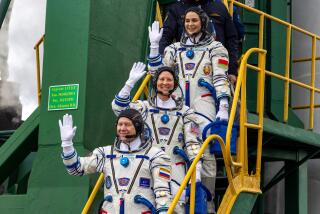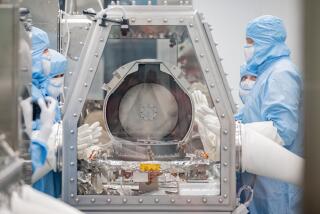For fourth time in history, space station crew forced to hide from space junk
A small piece of an old Russian weather satellite forced the crew of the International Space Station to take cover in an escape vehicle for a short time Thursday.
Officials at NASA Mission Control in Houston calculated that the fragment of space junk would pass close to the space station at 7:01 a.m. Central time. Based on the small chance of a “possible conjunction with the station,” flight director Ed Van Cise ordered ISS Commander Gennady Padalka and flight engineers Scott Kelly and Mikhail Kornienko to take shelter in a Soyuz vehicle that is docked at the station.
After the debris passed by safely, the crew was cleared to return to work.
Kelly tweeted his relief: “Happy there was no impact. Great coordination with international ground teams. Excellent training.”
All ISS systems continued to operate normally while the Russian cosmonauts and NASA astronaut were in the Soyuz vehicle.
More than 500,000 pieces of space junk are in Earth’s orbit, where they have the potential to do harm to satellites and the space station, according to NASA. Some of this debris is only 2 inches across, but because it travels at speeds of up to 17,500 mph, it can do real damage to anything in its path.
This was the fourth time that a space station crew has been relocated to a Soyuz in anticipation of a possible rendezvous with space junk, NASA said.
After the danger had passed, Van Cise offered a cutting-edge suggestion for dealing with the space junk threat.
“We need to launch a #SpaceSharknado where sharks have freakin’ laser beams on their heads #pewpewpew,” he tweeted.
Kelly and Kornienko are in the fourth month of a yearlong deployment on the ISS to help space experts anticipate some of the issues that would arise in a human mission to Mars. Kelly is part of an unusual twin experiment involving his identical twin brother, Mark Kelly, a former astronaut who last flew in space aboard the Space Shuttle Endeavour.
Three new crew members from the U.S., Russia and Japan are scheduled to fly to the space station July 22.
Follow me on Twitter @LATkarenkaplan and “like” Los Angeles Times Science & Health on Facebook.







